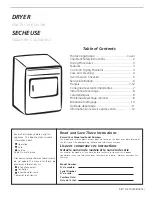
SOI/ADL 2009-10
7/63
599 72 40-73
2.1.2 Alarm display during normal operation
The system displays the family of alarms to the user by a repeated
flashing sequence of the ANTI-CREASE/END OF CYCLE LED (0.4
seconds on, 0.4 seconds off, with a 2.5 second pause between
sequences).
The buzzer emits a series of "bips" in synchronization with the flashing
of the LED
.
For example, in the case of alarm E53, the cycle would be interrupted and the ANTI-CREASE/END OF
CYCLE LED would flash repeatedly in the sequence shown in the table.
The five flashes indicate the
first
of the two numbers in the alarm code E
5
3 (the alarms relative to the same
function are grouped into families).
End of cycle
LED
Time (sec)
0.4
0.4
0.4
0.4
0.4
0.4
0.4
0.4
0.4
0.4
2.5
Value
1
2
3
4
5
Pause
Configuration errors (E93) are indicated by all the LEDs flashing.
2.1.3 Reading the alarm codes
To read the last alarm code memorized in the EEPROM of the electronic
board, proceed as follows:
•
Access diagnostics mode (see paragraph 9.1)
Turn the programme selector knob
clockwise
to the
eleventh position
2.1.4 Displaying the alarm code
The alarm code is displayed by a repeated sequence of flashing of the
ANTI-CREASE/END OF CYCLE LED (0.4 seconds on, 0.4 seconds off,
with a pause of 2.5 seconds between sequences).
The buzzer emits a
series of "bips" in synchronization with the flashing of the LED
.
N.B.:
•
The first letter of the alarm code "
E
" (error) is not displayed, since it is common to all codes.
•
The families of alarm codes are expressed in
hexadecimal
. Therefore;
A
is represented by
10
flashes
B
is represented by
11
flashes
F
is represented by
15
flashes
•
Configuration errors are displayed by the flashing of all the LEDs (user interface not configured).
ANTI-CREASE/END OF CYCLE LED:
indicates the first
number of the alarm code (family)
START/PAUSE LED:
indicates the second number of the
alarm code (number within the family category).








































